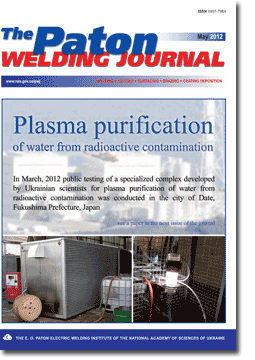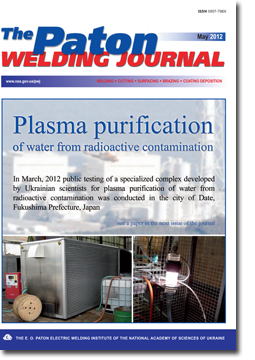| 2012 №05 (01) | 2012 №05 (03) |

The Paton Welding Journal, 2012, #5, 8-11 pages
EXPERIMENTAL STUDY OF THE MECHANISM OF HYDROGEN EMBRITTLEMENT OF METALS WITH THE BCC LATTICE
V.S. SINYUK, I.K. POKHODNYA, A.P. PALTSEVICH and A.V. IGNATENKO
E.O. Paton Electric Welding Institute, NASU, Kiev, Ukraine
Abstract
The study gives results of investigations of the effect of hydrogen on the mechanism of metal fracture. In metal containing diffusible hydrogen, plastic deformation leads to formation of residual hydrogen, which is connected to formed dislocations and microcracks. The presence of hydrogen connected to dislocations leads to localisation of plastic deformation of metal. Initiation of microcracks occurs by the shear mechanism, and their further growth takes place due to formation of new defects at the old crack apex and their coalescence.
Keywords: arc welding, low-carbon steel, hydrogen embrittlement, diffusible and residual hydrogen, hydrogen localisation of ductility
Received: 05.02.12
Published: 28.05.12
References
1. Ignatenko, A.V., Pokhodnya, I.K., Paltsevich, A.P. et al. (2012) Dislocation model of hydrogen-enhanced localizing of plasticity in metals with bcc lattice. The Paton Welding J., 3, 15-19.
2. Paltsevich, A.P. (1999) Chromatographic method for determination of hydrogen content in electrode coating components. Avtomatich. Svarka, 6, 45-48.
3. Pokhodnya, I.K., Shvachko, V.I., Stepanyuk, S.N. (2000) The evaluation methods of HSLA steels susceptibility to hydrogen embrittlement. In: Proc. of Int. Conf. on HSLA Steels (Xi'an, Chine, 2000), 453-458.
4. Bridgeman, P. (1955) Investigation of high plastic deformation and fracture. Moscow: Inostr. Literatura.
5. Kopelman, L.A. (1978) Resistance of welded assemblies to brittle fracture. Leningrad: Mashinostroenie.
6. Margolin, B.Z., Shvetsova, V.A., Karzov, G.P. et al. (2009) Development and application of local PROMETEY-approach for prediction of brittle fracture of reactor casing steels. Voprosy Materialovedeniya, 3, 290-314.
7. Kotrechko, S.A., Meshkov, Yu.Ya. (2008) Ultimate strength. Kiev: Naukova Dumka.
8. Gerberich, W.W., Stauffer, D.D., Sofronis, P.A. (2009) Coexistent view of hydrogen. In: Proc. of Int. Conf. on Effects on Mechanical Behavior of Crystals: HELP and HEDE Effects of Hydrogen on Materials (Wyoming, Sept. 7-10, 2008). Materials Park: ASM Int., 38-45.
9. Vladimirov, V.I. (1986) Physical nature of metal fracture. Moscow: Metallurgiya.
10. Robertson, I.M., Birnbaum, H.K. (2005) Dislocation mobility and hydrogen. In: Brief Rev. of Int. Conf. on Fracture (Turin, Italy, March 20-25, 2005). http://www. icf11.com/proceeding/EXTENDED/5759.pdf
Suggested Citation
V.S. SINYUK, I.K. POKHODNYA, A.P. PALTSEVICH and A.V. IGNATENKO (2012) EXPERIMENTAL STUDY OF THE MECHANISM OF HYDROGEN EMBRITTLEMENT OF METALS WITH THE BCC LATTICE. The Paton Welding J., 05, 8-11.The cost of subscription/purchase order journals or individual articles
| Journal/Currency | Annual Set | 1 issue printed |
1 issue |
one article |
| TPWJ/USD | 384 $ | 32 $ | 26 $ | 13 $ |
| TPWJ/EUR | 348 € | 29 € | 24 € | 12 € |
| TPWJ/UAH | 7200 UAH | 600 UAH | 600 UAH | 280 UAH |
| AS/UAH | 1800 UAH | 300 UAH | 300 UAH | 150 UAH |
| AS/USD | 192 $ | 32 $ | 26 $ | 13 $ |
| AS/EUR | 180 € | 30 € | 25 € | 12 € |
| SEM/UAH | 1200 UAH | 300 UAH | 300 UAH | 150 UAH |
| SEM/USD | 128 $ | 32 $ | 26 $ | 13 $ |
| SEM/EUR | 120 € | 30 € | 25 € | 12 € |
| TDNK/UAH | 1200 UAH | 300 UAH | 300 UAH | 150 UAH |
| TDNK/USD | 128 $ | 32 $ | 26 $ | 13 $ |
| TDNK/EUR | 120 € | 30 € | 25 € | 15 € |
AS = «Automatic Welding» - 6 issues per year;
TPWJ = «PATON WELDING JOURNAL» - 12 issues per year;
SEM = «Electrometallurgy Today» - 4 issues per year;
TDNK = «Technical Diagnostics and Non-Destructive Testing» - 4 issues per year.


